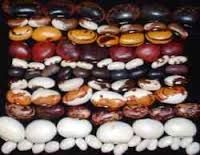
I started buying fancy heirloom beans from Napa merchant Rancho Gordo, and my family rapidly became big fans. Besides the flavor and texture they bring to the table, beans are nutritionally dense, packing impressive amounts of protein, complex carbohydrates, vitamins, minerals, antioxidants and phytochemicals.
About the same time I started eating more beans, I learned about the benefits that legumes provide to the soil. Beans belong to the same plant family as peas, alfalfa, runner beans and favas. These legumes have a unique relationship with nitrogen-fixing bacteria that live in nodules on their roots. The bacteria collect nitrogen from the air rather than the soil, so these plants need a lot less nitrogen fertilizer than many other vegetables.
Last year I decided to grow a few different kinds of shelling beans, both for the pleasure of producing my own supply as well as for the benefit of my vegetable patch. Choosing varieties was pretty simple: I chose beans that we like to eat. We grew flageolet, Christmas limas, tepary, runner beans and black valentine beans, plus an unnamed variety that a friend gave me from seed she had saved.
Just like green beans, shelling beans can be vining or bush types. Although commercial growers let the vines tangle on the ground, I wanted mine trellised for easier tending and harvesting. Since most of the beans I planted did not come from a traditional seed packet but from the specialty bean store, I looked online to find out which ones would climb and which would be bushy.
Beans need warm soil to germinate—at least 60°F, but 75°F to 85°F is better. In my Napa location, the soil warmed up toward the end of May. I planted beans from May 30 until June 14, placing them about an inch deep and spacing them two to three inches apart in double rows about a foot apart. For the bush types I didn’t remove any seedlings; I thinned the vining types to be four to six inches apart in the rows. I also set up sturdy supports for the pole beans when I sowed them so as not to disturb the roots later on. Seeds germinated within two weeks.
Birds can be a problem at the sprouting stage. I covered the new sprouts with berry baskets to prevent the birds from eating them. You could also use floating row cover until the plants are established.
Beans are not difficult to grow. They require regular watering and perhaps some help in finding their way up the trellis. Snails, slugs and earwigs like them, so be on the watch for these pests. In areas that get summer rain, beans can succumb to bacterial and fungal disease. Water at ground level to prevent these problems.
Shelling beans can take anywhere from 70 to 120 days to mature fully. In my garden last year, most of the varieties started to dry out in September. For the bush types, when about half the plants were starting to brown, I cut off all the plants and spread them on a sheet to finish drying. I laid them in a warm, sunny spot during the day and brought them in at night so that the dew would not dampen them. When the beans are dry enough, the pods will shatter easily. Placing the pods in a sack and beating it will release most of the beans.
For the vining types, I harvested all the brown dry pods daily and left them in baskets to get thoroughly dry. Guests and grandchildren enjoyed shelling the beans, but I also could have threshed the beans by the bag method.
Once the beans were shelled, I let them dry some more before storing in glass jars. If they are not fully dry, they can rot during storage. By the end of October, all of my beans were harvested and stored.
We have been enjoying those beans all winter. This summer, I’ll grow our favorites from last year and try some new ones, too. After all, there are several hundred types I haven’t tried yet.
Workshop: Napa County Master Gardeners will conduct a workshop on “Container Gardening” on Saturday, May 18, from 9:30 a.m. to 11:30 a.m., at the University of California Cooperative Extension office (address below). Learn to grow mobile gardens that take advantage of the best sites in your yard or home. Discover the best containers, soils and locations for your plants to prosper. Online registration (credit card only) Mail in registration (cash or check only)
Master Gardeners are volunteers who help the University of California reach the gardening public with home gardening information. Napa County Master Gardeners (http://cenapa.ucdavis.edu) are available to answer gardening questions in person or by phone, Monday, Wednesday and Friday, 9 a.m. to Noon, at the U. C. Cooperative Extension office, 1710 Soscol Avenue, Suite 4, Napa, 707-253-4143, or from outside City of Napa toll-free at 877-279-3065. Or e-mail your garden questions by following the guidelines on our web site. Click on Napa, then on Have Garden Questions?